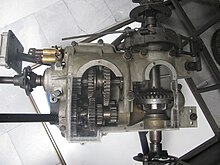
A sports car is a type of car that is designed with an emphasis on dynamic performance, such as handling, acceleration, top speed, the thrill of driving, and racing capability. Sports cars originated in Europe in the early 1910s and are currently produced by many manufacturers around the world.

A four-wheel drive, also called 4×4 or 4WD, is a two-axled vehicle drivetrain capable of providing torque to all of its wheels simultaneously. It may be full-time or on-demand, and is typically linked via a transfer case providing an additional output drive shaft and, in many instances, additional gear ranges.

Front-wheel drive (FWD) is a form of engine and transmission layout used in motor vehicles, in which the engine drives the front wheels only. Most modern front-wheel-drive vehicles feature a transverse engine, rather than the conventional longitudinal engine arrangement generally found in rear-wheel-drive and four-wheel-drive vehicles.

In automotive design, an RR, or rear-engine, rear-wheel-drive layout places both the engine and drive wheels at the rear of the vehicle. In contrast to the RMR layout, the center of mass of the engine is between the rear axle and the rear bumper. Although very common in transit buses and coaches due to the elimination of the drive shaft with low-floor buses, this layout has become increasingly rare in passenger cars.

In automotive design, an RMR, or rear mid-engine, rear-wheel-drive layout is one in which the rear wheels are driven by an engine placed with its center of gravity in front of the rear axle, and thus right behind the passenger compartment. Nowadays more frequently called 'RMR', to acknowledge that certain sporty or performance focused front-engined cars are also "mid-engined", by having the main engine mass behind the front axle, RMR layout cars were previously just called MR, or mid-engine, rear-wheel-drive layout), because the nuance between distinctly front-engined vs. front mid-engined cars often remained undiscussed.
Rear-wheel drive (RWD) is a form of engine and transmission layout used in motor vehicles, in which the engine drives the rear wheels only. Until the late 20th century, rear-wheel drive was the most common configuration for cars. Most rear-wheel drive vehicles feature a longitudinally-mounted engine at the front of the car.
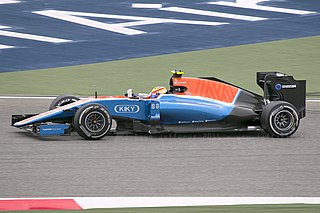
In automotive engineering, a mid-engine layout describes the placement of an automobile engine in front of the rear-wheel axles, but behind the front axle.

A drive shaft, driveshaft, driving shaft, tailshaft, propeller shaft, or Cardan shaft is a component for transmitting mechanical power, torque, and rotation, usually used to connect other components of a drivetrain that cannot be connected directly because of distance or the need to allow for relative movement between them.
Getrag, stylized as GETRAG, was a major supplier of transmission systems for passenger cars and commercial vehicles. The company was founded on 1 May 1935, in Ludwigsburg, Germany, by Hermann Hagenmeyer; as the Getriebe und Zahnradfabrik Hermann Hagenmeyer GmbH & Cie KG.
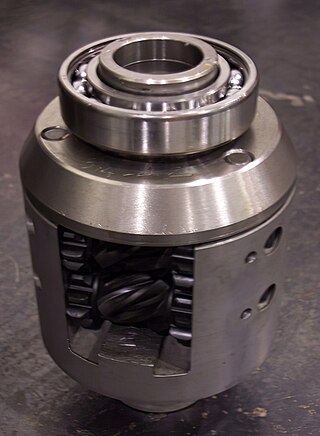
Torsen Torque-Sensing is a type of limited-slip differential used in automobiles.

The Geneva International Motor Show was an annual auto show held in March in the Swiss city of Geneva.
ATTESA is a four-wheel drive system used in some automobiles produced by the Japanese automaker Nissan, including some models under its luxury marque Infiniti.
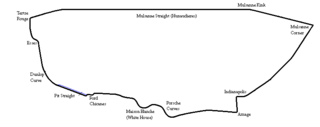
The 1973 24 Hours of Le Mans was the 41st Grand Prix of Endurance and took place on 9 and 10 June 1973. It was the eighth round of the 1973 World Championship of Makes.
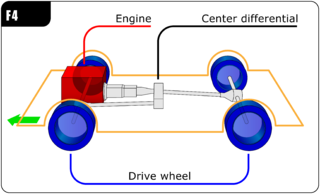
In automotive design, an F4, or front-engine, four-wheel drive (4WD) layout places the internal combustion engine at the front of the vehicle and drives all four roadwheels. This layout is typically chosen for better control on many surfaces, and is an important part of rally racing, as well as off-road driving. In terms of racing purposes, whether it be on-road or off-road, can be described as follows,
A team that pursues the Weak LS4WD architecture will minimize the development cost of the front-wheel drive system at the expense of having a larger rear powertrain. The Weak architecture produces a vehicle with a large powersplit between the front and rear powertrains, while the Strong architecture recommends a vehicle with more similar power and torque requirements for the front and rear.

Kelmark Engineering was an American automotive specialty shop established in 1969 and based in Okemos, Michigan. It focused on high-performance custom V8 drivetrain swaps, the modification and production of rear and mid-engined cars, and custom-built turn-key automobiles. Until 1986, Kelmark Engineering manufactured kits and complete, finished, turn-key vehicles which were either Volkswagen-based or built on tubular race car-type frames. The outfit gained its name from Jim Kellison and Randy Markham, the two co-creators who started the operation. Up until at least 1989, the Kelmark GT was still available as a kit albeit the manufacturer was Kelmark Motors in Holt, Michigan. The cars are all "rare" models, but the Volkswagen-powered Kelmark GT was the most popular.

The 2010 Paris Motor Show took place from 2 October to 17 October 2010, in Paris expo Porte de Versailles.

Driven to Distraction is a non-fiction book, first published in 2009, written by English journalist and television presenter Jeremy Clarkson. The book is a collection of Clarkson's articles for the Sunday Times newspaper, all originally published in 2006 and 2007. The articles consist of car reviews combined with rants on current events.

A dual-clutch transmission (DCT) is a type of multi-speed vehicle transmission system, that uses two separate clutches for odd and even gear sets. The design is often similar to two separate manual transmissions with their respective clutches contained within one housing, and working as one unit. In car and truck applications, the DCT functions as an automatic transmission, requiring no driver input to change gears.
Dana Graziano is an Italian company based in Turin manufacturing gearboxes, drivelines and their mechatronics components. It makes the "Pre-Cog" seven-speed Seamless-Shift gearbox (SSG) dual-clutch transmission used in the McLaren 12C.
The Milano Monza Open-Air Motor Show (MIMO) is an annual auto show first held in June 2021 in Milan and Monza, Italy.
